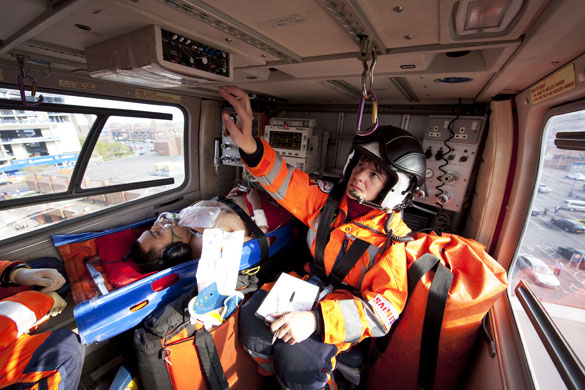There are several possible explanations for the decrease in the murder rate in London over the last decade: longer sentences, better living standards, better policing and detective work, a decline in drug use, or perhaps just a greater respect for human life in general.
All have a part to play, but it is easy to overlook the role of emergency medicine in saving the lives of victims of serious assaults who would otherwise be added to the homicide statistics.
One of those survivors is Daniel Alaile, who was 16 when he was stabbed in the chest while making his way home from a birthday party in Beckton, east London, in January 2010.
The knife penetrated his left ventricle, causing massive internal bleeding. He had just ten minutes before his brain died of oxygen starvation.
Five miles away the London Air Ambulance took off from the top of the Royal London Hospital in Whitechapel.

Within seconds of its arrival Daniel was undergoing a major operation called a thoracotomy, right there at the roadside. His chest was cut open, the damaged left ventricle was sewn up and his heart restarted using a shot of adrenaline.
Although he was left wheelchair bound as a result of a blood-clotting disorder, Daniel would give evidence at the Old Bailey 16 months later. It could easily have been a murder trial, rather than attempted murder.
That year, 2010, the Air Ambulance attended 1,981 incidents in total. They included 318 stabbings and 73 shootings. The crew performed 26 thoracotomies, an average of one a fortnight. They have already exceeded that for 2011.
Long-term success rates for those who undergo the procedure are running at 18 per cent – meaning four or five people survive what would otherwise be fatal injuries. In the context of roughly 120 murders last year (down from more than 200 in 2003) it is a small but not insignificant proportion.
Formed in 1989, the London Air Ambulance now seems like a prototype ‘Big Society’ venture. It is a registered charity and has to find £2.2m a year just to keep going, including sponsorship from Virgin, HSBC and local businesses as well as fundraising events.
It is also a pioneering enterprise. In 1993 it became the world’s first medical service to successfully carry out a thoracotomy at the scene of the attack. Based at the Royal London Hospital in Whitechapel, the helicopter can attend a patient anywhere within the M25 within 15 minutes. That includes even crowded public spaces like Trafalgar Square or the busy Euston Road.
The emergency services are also likely to benefit from medical improvements being developed in the battle zones of Afghanistan and Iraq, as featured in the fascinating programme ‘Frontline Medicine’ on BBC 2 last month.
In some cases casualties are given more than 150 units of blood (the human body usually contains between 10 and 12 units) as well as blood plasma and clotting factors. As a result they are saving a quarter of those expected to die, compared to rates for civilians of around five per cent.
Soldiers are trained to take act quickly to help their injured squadmates by stopping blood loss as soon as possible and ensuring they get treatment within the so-called ‘Platinum Ten Minutes’ (better than the old-style ‘Golden Hour’).
While this isn’t directly applicable to the streets of London, clinical trials of new blood transfusion procedures are now underway in England and Wales, including at the Barts and The London Trauma Centre, which includes the London Air Ambulance (also known as The Helicopter Emergency Medical Service (HEMS)).
At the moment the helicopter cannot carry blood supplies because of regulations concerning tracking of supplies and their storage at the correct temperature. However this could soon change. The Barts and The London NHS Trust say they are ‘close’ to resolving the issues and should have good news in ‘the very near future.’
This would give victims of knife and gunshot injuries an even better chance of survival. And while it doesn’t solve the problem of people using knives and guns on the streets of London, it at least reduces the human cost of crime.
_______
Recommended reading:
The excellent website of the London Air Ambulance provides much more information on this vital service and how you can help raise money to keep it going.
Photographer David Levene spent eight months with the team as they responded to emergency situations across the capital. The Guardian featured 16 of his pictures, including the one above.